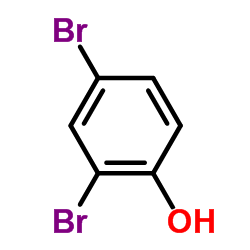2,4-Dibromophenol

2,4-Dibromophenol structure
|
Common Name | 2,4-Dibromophenol | ||
|---|---|---|---|---|
| CAS Number | 615-58-7 | Molecular Weight | 251.903 | |
| Density | 2.1±0.1 g/cm3 | Boiling Point | 238.5±0.0 °C at 760 mmHg | |
| Molecular Formula | C6H4Br2O | Melting Point | 36-39 °C | |
| MSDS | Chinese USA | Flash Point | 101.2±21.8 °C | |
| Symbol |

GHS06 |
Signal Word | Danger | |
|
cIEF for rapid pKa determination of small molecules: a proof of concept.
Eur. J. Pharm. Sci. 63 , 14-21, (2014) A capillary isoelectric focusing (cIEF) method was developed for the determination of the ionization constants (pKa) of small molecules. Two approaches used to decrease the electroosmotic flow (EOF) were compared: (i) a hydroxypropylcellulose (HPC) coated cap... |
|
|
Human hydroxylated metabolites of BDE-47 and BDE-99 are glucuronidated and sulfated in vitro.
Toxicol. Lett. 236 , 98-109, (2015) Polybrominated diphenyl ethers (PBDEs) were used worldwide as additive flame retardants and are classified as persistent, bioaccumulable and toxic environmental pollutants. In humans, the hydroxylated metabolites of 2,2',4,4'-tetrabromodiphenyl ether (BDE-47)... |
|
|
Catalytic degradation of brominated flame retardants by copper oxide nanoparticles.
Chemosphere 93(1) , 172-7, (2013) The catalytic degradation of two brominated flame retardants (BFRs), tribromoneopentyl alcohol (TBNPA) and 2,4 dibromophenol (2,4-DBP) by copper oxide nanoparticles (nCuO) was investigated. The degradation kinetics, the debromination, and the formation of int... |
|
|
Enhancement of bromophenol levels in aquacultured silver seabream (Sparus sarba).
J. Agric. Food Chem. 53(6) , 2133-9, (2005) The effect of the addition of marine algae in fish feed on the levels of bromophenols in fish flesh was studied. These bromophenols include 2-bromophenol, 4-bromophenol, 2,4-dibromophenol, 2,6-dibromophenol, and 2,4,6-tribromophenol. Two types of algae-contai... |
|
|
Biodegradation of brominated aromatics by cultures and laccase of Trametes versicolor.
Chemosphere 76(6) , 826-32, (2009) 2-Bromophenol (1), 4-bromophenol (2), 2,4-dibromophenol (3), 2,6-dibromophenol (4), 2,4,6-tribromophenol (5) and tetrabromobisphenol A (6) (1 mM each) added to growing submerged cultures of Trametes versicolor CCBAS 612 were eliminated by 65-85% from the cult... |
|
|
Kinetic bromine isotope effect: example from the microbial debromination of brominated phenols.
Anal. Bioanal. Chem 405(9) , 2923-9, (2013) The increasing use of kinetic isotope effects for environmental studies has motivated the development of new compound-specific isotope analysis techniques for emerging pollutants. Recently, high-precision bromine isotope analysis in individual brominated orga... |
|
|
Formation of 2′-hydroxy-2,3′,4,5′-tetrabromodipheyl ether (2′-HO-BDE68) from 2,4-dibromophenol in aqueous solution under simulated sunlight irradiation
Chemosphere 84(4) , 512-8, (2011) Highlights ► 2′-HO-BDE68 can be generated from bromophenol through photochemical approaches. ► 2′-HO-BDE68 formation depends on bromophenol concentration, pH and light intensity. ► Iron and fulvic acid influence significantly the generation of 2′-HO-BDE68. |
|
|
The marine secondary metabolites 2,4-dibromophenol and 2,4,6-tribromophenol differentially modulate voltage dependent ion currents in neuroendocrine (PC12) cells.
Aquat. Toxicol. 79(4) , 384-90, (2006) 2,4-Dibromophenol (2,4-DBP) and 2,4,6-tribromophenol (2,4,6-TBP) are marine secondary metabolites, with 2,4,6-tribromophenol playing an important role as industrially produced flame retardant and pesticide. Both substances disturb cellular calcium signals in ... |
|
|
Improved approach for analyzing bromophenols in seafood using stable isotope dilution analysis in combination with SPME.
J. Agric. Food Chem. 56(18) , 8248-54, (2008) An analytical method for the measurement of five naturally occurring bromophenols of sensory relevance in seafood (barramundi and prawns) is presented. The method combines simultaneous distillation-extraction followed by alkaline back extraction of a hexane e... |
|
|
[Analysis of 2,4-dibromophenol and 2,6-dibromophenol in phenolic-smelling flatfish].
Shokuhin Eiseigaku Zasshi 50(6) , 292-6, (2009) A simple analytical method for dibromophenols (DBPs) in flatfiish was developed. 2,4-DBP and 2,6-DBP were extracted from a sample with acetone and n-hexane, cleaned up by treatment with conc. sulfuric acid and concentrated under a stream of nitrogen gas. The ... |